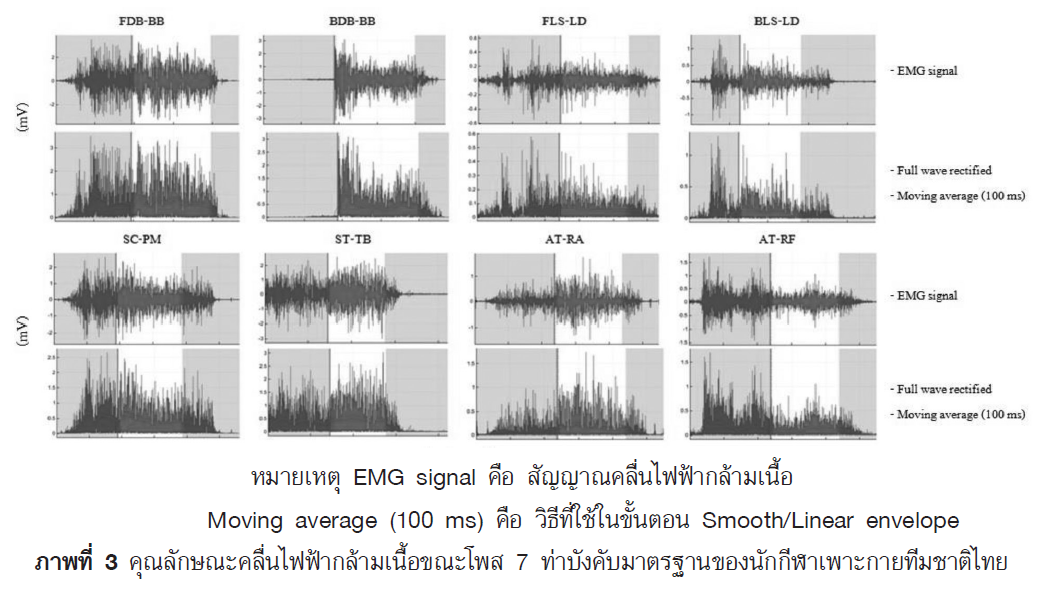EMG CHARACTERISTICS DURING 7 MANDATORY POSES IN THAI NATIONAL MALE BODYBUILDERS
Main Article Content
Abstract
Abstract Objectives : Purpose The purpose of this research was to study the characteristics and compare the mean and peak electromyography (EMG) while posing 7 standard poses of Thai national bodybuilding athletes. Methods : A total of 10 Thai national bodybuilding athletes (3 World champions and 7 Asian champions) participated in this study. The EMG signals from Biceps brachii (BB), Triceps brachii (TB), Latissimus dorsi (LD), Pectoralis major (PM), Rectus abdominis (RA) and Rectus femoris (RF) were recorded at the frequency of 2,400 Hz while posing for Front double biceps (FDB), Back double biceps (BDB), Front lat spread (FLS), Back lat spread (BLS), Side chest (SC), Side triceps (ST) and Abdominals and Thighs (AT). EMG data were selected in accordance with Bodybuilding and Fitness Sports Association of Thailand’s referee for the best pose and were analyzed with Qualisys track manager software. the mean and peak EMG values of BB, RA, RF, and TB were highest (~30% MVIC and ~50% MVIC, respectively) during AT, FDB, BDB, and ST poses and were lowest (~15% MVIC and ~20% MVIC, respectively) during PM at SC pose. Interestingly, LD showed the least EMG activity (less than 10%MVIC) dur-ing SC, FLS and BLS poses. There were no difference in EMG activity between BB and LD muscles on both the left and right sides, except for BDB pose. Conclusion : EMG activity and pattern of muscles studied varied during 7 mandatory poses. This finding can be used as a reference to the muscle control during champion bodybuilder’s posing and can be applied to training 7 standard poses for novice bodybuilders.
Article Details
References
Barclay, C. J. (2015). Energetics of Contraction. In Comprehensive Physiology, R. Terjung (Ed.). pp. 961-995.
Barré, A., & Armand, S. (2014). Biomechanical ToolKit: Open-source Framework to visualize and process biomechanical data. Computer Methods and Programs in Biomedicine, 114, 80-87. doi: 10.1016/j.cmpb.2014.01.012
Bauer, A. (2018). WBPF Rules Book Bodybuilding, Fitness Physique, Athletic Physique, Sport Physique, Model Physique and Mixed Pairs: World Bodybuilding & Physique Sport Federation.
Coratella, G., Tornatore, G., Caccavale, F., Longo, S., Esposito, F., & Cè, E. (2021). The activation of gluteal, thigh, and lower back muscles in different squat variations performed by competitive bodybuilders: Implications for resistance training. International Journal of Environmental Research and Public Health, 18(2). doi: 10.3390/ ijerph18020772
Coratella, G., Tornatore, G., Longo, S., Esposito, F., & Cè, E. (2020a). An Electromyographic Analysis of Lateral Raise Variations and Frontal Raise in Competitive Bodybuilders. International journal of environmental research and public health, 17(17), 6015. doi: 10.3390/ijerph17176015
Coratella, G., Tornatore, G., Longo, S., Esposito, F., & Cè, E. (2020b). Specific prime movers’ excitation during free-weight bench press variations and chest press machine in competitive bodybuilders. European Journal of Sport Sciences, 20(5), 571-579. doi: 10.1080/17461391.2019.1655101
Hermens, H. J., Freriks, B., Disselhorst-Klug, C., & Rau, G. (2000). Development of recommendations for SEMG sensors and sensor placement procedures. Journal of Electromyography and Kinesiology, 10(5), 361-374. doi: https://doi.org/10.1016/S1050-6411(00)00027-4
Konrad, P. (2005). The abc of EMG: A practical introduction to kinesiological electromyography. Noraxon Inc. USA, version 1.0.
Maeo, S., Takahashi, T., Takai, Y., & Kanehisa, H. (2013). Trainability of muscular activity level during maximal voluntary co-contraction: Comparison between bodybuilders and non-athletes. PloS one, 8, e79486. doi: 10.1371/ journal.pone.0079486
Marcolin, G., Panizzolo, F. A., Petrone, N., Moro,T., Grigoletto, D., Piccolo, D., & Paoli, A. (2018). Differences in electromyographic activity of biceps brachii and brachioradialis while performing three variants of curl. PeerJ, 6, e5165-e5165. doi: 10.7717/peerj.5165
Rash, G. (2002). Electromyography Fundamentals. International Encyclopedia of Ergonomics and Human Factors.
Santonja, R. (2017). IFBB Rules Section 2: Men’s Bodybuilding: International Federation of Bodybuilding & Fitness (IFBB).
Tesch, P. A., & Larsson, L. (1982). Muscle hypertrophy in bodybuilders. European Journal Applied Physiology, 49(3), 301-306.doi: 10.1007/bf00441291


